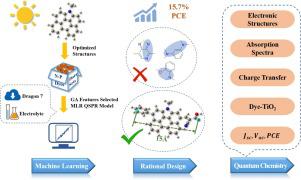Materials Today Communications ( IF 3.8 ) Pub Date : 2020-09-12 , DOI: 10.1016/j.mtcomm.2020.101604 Lifei Ju , Minjie Li , Lumin Tian , Pengcheng Xu , Wencong Lu

|
Dye-Sensitized Solar Cells (DSSCs) show the most promising future of photovoltaic devices due to the low cost, facile fabrication, cleanliness, and stable performance. In this work, we proposed one goal-directed method using data mining techniques integrated with quantum chemical analysis to design N-annulated perylene sensitizers. We constructed the robust quantitative structure-property relationship (QSPR) model via multiple linear regression (MLR), while the genetic algorithm (GA) was employed to select the crucial features. Then we designed the potential dyes according to the model guidance. The model predicted overall power conversion efficiencies (PCEs) of the designed molecules reached 15.7%, increasing by 22.0% compared to reference dyes C281. Besides, density functional theory (DFT) and time-dependent density functional theory (TD-DFT) calculations revealed the more favorable charge-transfer and optoelectronic properties of new molecules. They have narrow bandgaps (up to a 20.6% reduction), excellent light-harvesting efficiency (LHE) curves, and large maximum short-circuit current densities (20.5% increase). More importantly, the PCE values simulated by quantum chemistry are highly consistent with the values predicted by QSPR models. The designed N-annulated perylene dyes could be sensitizer candidates for highly efficient DSSCs. The novel goal-directed approach could potentially accelerate the discovery of other advanced energy materials and could offer valuable contributions to the development of photovoltaic devices.
中文翻译:

通过机器学习和量子化学加速发现用于太阳能电池的高效N型环per有机敏化剂
染料敏化太阳能电池(DSSC)由于成本低,制造方便,清洁和性能稳定而显示出最有前途的光伏器件。在这项工作中,我们提出了一种使用数据挖掘技术与量子化学分析相集成的目标导向方法来设计N环化per敏化剂。我们通过多元线性回归(MLR)构建了鲁棒的定量结构-性质关系(QSPR)模型,同时采用遗传算法(GA)选择关键特征。然后我们根据模型指导设计了潜在的染料。该模型预测,设计分子的整体功率转换效率(PCE)达到15.7%,与参考染料C281相比提高22.0%。除了,密度泛函理论(DFT)和时变密度泛函理论(TD-DFT)计算显示出新分子更有利的电荷转移和光电特性。它们具有较窄的带隙(降低了20.6%),出色的光收集效率(LHE)曲线以及较大的最大短路电流密度(提高了20.5%)。更重要的是,量子化学模拟的PCE值与QSPR模型预测的值高度一致。设计的N型环per染料可能是高效DSSC的敏化剂候选物。这种新颖的以目标为导向的方法可以潜在地加速其他先进能源材料的发现,并可以为光伏设备的开发提供宝贵的贡献。



























 京公网安备 11010802027423号
京公网安备 11010802027423号